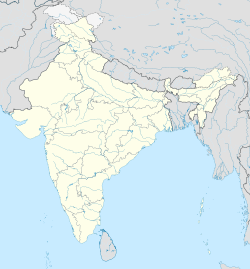Arrah
| Arrah | ||
|---|---|---|
|
|
||
| State : |
|
|
| State : | Bihar | |
| District : | Bhojpur | |
| Location : | 25 ° 33 ' N , 84 ° 39' E | |
| Height : | 190 m | |
| Area : | 18 km² | |
| Residents : | 261,099 (2011) | |
| Population density : | 14,506 inhabitants / km² | |
| Website : | http://arrah.biharurban.in/ | |
Arrah is a city in the Indian state of Bihar with around 260,000 inhabitants (2011 census).
It is 40 kilometers west of Patna and 200 kilometers east of Varanasi , where it is a local trading center surrounded by intensively used agricultural land.
The city is located on the Son Canal and a good 15 kilometers south of the Ganges in the Bhojpur district , of which it is also the capital.
geography
Arrah is located 25.33 degrees north and 84.39 degrees east at an altitude of 190 meters above sea level on almost completely flat land. The settlement area extends about 6 kilometers along the east-west railway connection (between Patna and Varanasi ) and has an area of about 18 km².
There are also several small lakes within the city, but they are often very polluted.
climate
In summer there is a very humid, hot monsoon climate , the often heavy rainfall of which floods the city and its surroundings for months. The winter months, on the other hand, are mostly dry and much cooler.
history
Arrah's "prehistory" is defined by a myth . The good-natured King Moradhwaj lived long ago in the area of present-day Arrah and was very unhappy that he had not yet had a son to succeed him. So he and his wife pleaded with the goddess Durga , who then blessed him with a son in a dream.
When he was born and older, Durga appeared again to the king in a dream and demanded this very child to be sacrificed. The goddess also demanded that the sacrifice be cut in half with a saw, whereupon the legend of the prince submitted without resistance and followed divine instructions.
So a temple was built in memory of the goddess Durga at that point of the “divine sacrifice”, which is still venerated today as the Aranya Devi temple and visited by hundreds of believers every day.
population
According to the 2001 census, there were 203,000 people in Arrah, and according to a 2010 calculation, the figure is nearly 250,000; However, it can be assumed that significantly more people will populate the city, as it is located in one of the most densely populated areas in India and a strong rural exodus across the country is causing the population in the cities to rise rapidly. Overall, the 2001 statistics show that the illiteracy rate is significantly higher than the national average, and Arrah is still in an economically less developed state.
Attractions
The Aranya Devi Temple , located in the middle of the city, is considered a religious center, where the believers today make offerings of bread and sweets to the goddess Durga. There are also several temples in the city, including the Moti Mahal . The oldest mosque in the city is the Shahi Masjid, built in 1623 near the Aranya Devi Temple, which was built in the time of Shahjahan , and the Maulabagh Mosque from 1817.
Economy and Infrastructure
As a center in an agriculturally very intensively used region, the trade in the main products grain ( wheat , maize ) and sugar cane as well as oilseeds is still the most important branch of the economy . But industries such as chemistry (Aurah Bihar Chemical Industries) or a glass factory (Mau Durga Glass Industry) have also settled here.
In Arrah there is currently a large hospital , the centrally located Sadar Hospital, as well as a renovated, large hotel of international standards, the Regal Hotel Arrah.
traffic
The city has a train station and is well connected to the railway network. It also has a small airport and is mostly connected to other cities by trunk roads in an east-west direction. The nearby Arrah – Chhapra Bridge has been crossing the Ganges since 2017 . The chaotic Main Bus Terminal regulates most of the long-distance bus traffic.
education
With several educational institutions, the place is of regional importance:
The Maharaja College is the largest and oldest college in the city. The institution has existed since 1954, founded by Maharaja Shri Kamal Singh of Dumraon in memory of his late father, the philanthropist Bhadur Ram Prasad Singh Vijay Ran. For this purpose, the Maharaja donated the building land in the middle of the city, into which the famous “Ara House” was incorporated, which has a local, historical significance in relation to the liberation of the English occupation. Several thousand pupils and students study in the ten buildings.
There is also a large girls' school in Arrah and a Jain college in the south of the city.
Web links
- Arrah Nagar Nigam (City Council)
- Arrah, Bihar . In: Indianetzone.com, accessed December 1, 2010
- World Gazetteer: Arrah , accessed December 1, 2010
- Maharaja College in Arrah website , accessed December 1, 2010
